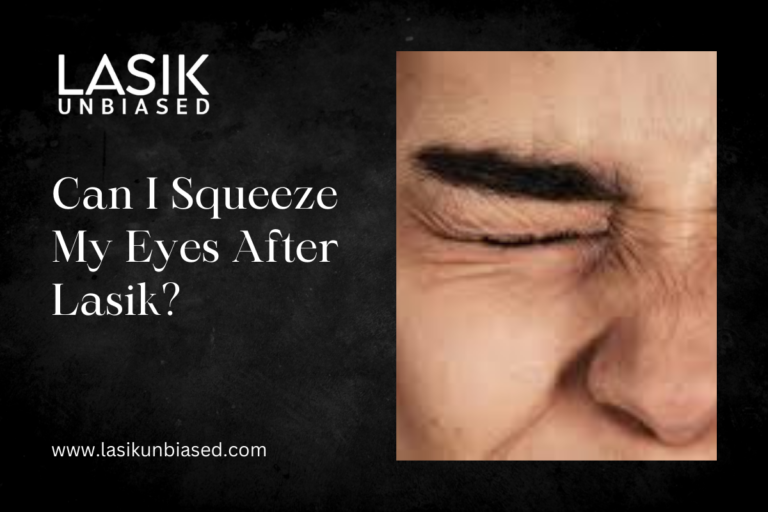LASIK surgery offers a quick and effective way to achieve clear vision without glasses or contact lenses. However, the recovery period is crucial for ensuring the best possible results.
Patients must follow post-operative care instructions carefully to protect their eyes and avoid complications. One of the most common concerns after LASIK is whether squeezing, rubbing, or applying pressure to the eyes is safe.
Why You Should Avoid Squeezing Your Eyes After LASIK?
Risk of Flap Displacement
During LASIK, a thin flap is created on the cornea’s surface and lifted to reshape the underlying tissue. After the procedure, the flap is repositioned without stitches and naturally adheres to the cornea. However, in the early stages of healing, the flap remains delicate and can shift out of place if too much pressure is applied to the eyes. Squeezing, rubbing, or pressing on the eyes increases the risk of flap displacement, which can lead to vision disturbances, discomfort, or the need for additional surgical intervention.
Increased Risk of Infection
The healing cornea is vulnerable to infections after LASIK. Touching or squeezing the eyes introduces bacteria from the hands, increasing the risk of infection. Even if the eyes feel dry, itchy, or irritated, resisting the urge to squeeze or rub them is essential. Using prescribed antibiotics and lubricating eye drops as the surgeon directs helps moisten the eyes and reduces discomfort without physical contact.
Delayed Healing and Irritation
Squeezing the eyes tightly can strain the cornea and disrupt the natural healing process. The force exerted on the eyes can cause inflammation, discomfort, or excessive tearing, making recovery longer than necessary. Patients who experience persistent irritation should consult their eye doctor rather than attempting to relieve discomfort by squeezing or rubbing their eyes.
What to Do Instead of Squeezing Your Eyes?
Use Lubricating Eye Drops
Many patients experience dry eyes after LASIK, leading to a sensation of grittiness or irritation. Instead of squeezing or rubbing the eyes, artificial tears, as the doctor recommends, provide relief and keep the eyes hydrated. Preservative-free lubricating drops are the best option for preventing irritation.
Blink Gently
If the eyes feel dry or tired, gentle blinking can help spread natural tears across the eye’s surface. This relieves discomfort without putting unnecessary pressure on the cornea. Avoid forcefully shutting the eyes, as this can create temporary fluctuations in vision and increase irritation.
Wear Protective Eyewear
Wearing protective goggles or sunglasses can help prevent accidental eye rubbing during the first few days after LASIK. Patients should wear the provided eye shields at night to avoid unintentional pressure on the eyes while sleeping.
Follow the Doctor’s Instructions
Post-operative care guidelines are designed to ensure smooth healing and prevent complications. Patients should attend follow-up appointments, use prescribed medications, and avoid activities that may strain their eyes unnecessarily.
When Is It Safe to Touch the Eyes Again?
The corneal flap begins to heal within the first few days after LASIK, but it takes several weeks to stabilize fully. Most surgeons recommend avoiding any pressure on the eyes for at least two weeks after surgery. Even after this period, patients should always be gentle when touching their eyes and avoid excessive rubbing. If any discomfort persists, consulting an eye specialist is the best action.
Squeezing the eyes after LASIK is unsafe, as it can cause flap displacement, increase the risk of infection, and delay healing. Instead, patients should use lubricating drops, blink gently, and wear protective eyewear to ensure a smooth recovery. Following the surgeon’s post-operative care instructions and avoiding unnecessary pressure on the eyes will help preserve the long-term benefits of LASIK and maintain clear vision.
Additional Considerations for Eye Care After LASIK
Managing Discomfort Without Squeezing the Eyes
It is common to experience mild discomfort, dryness, or a foreign body sensation after LASIK. While these symptoms may create an instinctive urge to squeeze or rub the eyes, there are safer ways to find relief. When applied gently over closed eyelids, cold compresses can help soothe irritation without exerting pressure on the cornea. Additionally, staying hydrated and using a humidifier in dry environments can reduce eye dryness and discomfort, making it easier to avoid squeezing the eyes.
The Impact of Squeezing on Eye Pressure
Squeezing the eyes tightly can temporarily increase intraocular pressure (IOP), which may not be ideal during the initial healing period after LASIK. A sudden rise in eye pressure could affect the delicate healing tissue and interfere with the stability of the corneal flap. While brief, minor squeezing is unlikely to cause severe damage, repeated or forceful squeezing could lead to complications such as prolonged inflammation or vision fluctuations. Patients should be mindful of their eye movements and avoid any unnecessary strain.
The Role of Post-LASIK Medications
LASIK patients receive medicated eye drops, including antibiotics and anti-inflammatory solutions, to minimise irritation and prevent infections. Proper usage of these drops significantly reduces the chances of discomfort, making it easier to resist the urge to squeeze the eyes. Patients should follow the prescribed dosage and duration, as stopping medications too soon or overusing drops can cause further irritation.
How Long Should You Be Cautious?
While the risk of serious complications from squeezing the eyes decreases as healing progresses, patients should still be cautious for the first few months. The corneal flap remains more vulnerable in the initial weeks, so it is essential to be mindful during this period. By the one-month mark, most people can resume regular activities without significant restrictions, but gentle handling of the eyes remains essential for long-term eye health.
When to Seek Medical Advice?
If a patient accidentally squeezes or rubs their eyes and notices sudden vision changes, discomfort, or increased redness, they should contact their eye doctor immediately. A quick examination can rule out complications and ensure the corneal flap remains intact. Prompt medical attention prevents minor issues from turning into serious problems and helps maintain the long-term success of LASIK surgery.
By taking these precautions and following post-LASIK care instructions, patients can ensure a smooth recovery and enjoy the benefits of clear vision without unnecessary risks.


